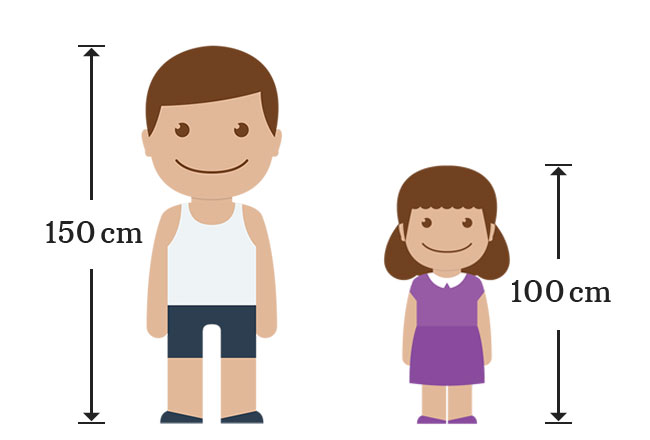A number that appears as a ratio of any two integers is called a rational number.
The integers are often appeared in antecedent and consequent positions of the ratio in some cases. The ratio of them is also a number and it is called as a rational number.
$\dfrac{1}{4}$, $\dfrac{-7}{2}$, $\dfrac{0}{8}$, $\dfrac{11}{8}$, $\dfrac{15}{5}$, $\dfrac{14}{-7}$, $\cdots$

The rational numbers are mainly used to represent the fractions in mathematical form.
There are two rules for forming the rational numbers by the integers.
$10$ and $2$ are two integers and find the ratio of $10$ to $2$ by the division.
$Ratio \,=\, \dfrac{10}{2}$
It is a rational number basically and now, find their quotient.
$\implies$ $\dfrac{10}{2}$ $\,=\,$ $5$
It proves that a rational number can be an integer but an integer may not always be a rational number.
The heights of a boy and his sister are $150 \, cm$ and $100 \, cm$ respectively.

Calculate the ratio of boy’s height to his sister’s height.
$Ratio \,=\, \dfrac{150}{100}$
$\implies$ $\require{cancel} Ratio \,=\, \dfrac{\cancel{150}}{\cancel{100}}$
$\implies$ $\require{cancel} Ratio \,=\, \dfrac{3}{2}$
Similarly, calculate the ratio of girl’s height to her brother’s height.
$Ratio \,=\, \dfrac{100}{150}$
$\implies$ $\require{cancel} Ratio \,=\, \dfrac{\cancel{100}}{\cancel{150}}$
$\implies$ $\require{cancel} Ratio \,=\, \dfrac{2}{3}$
$\dfrac{2}{3}$ and $\dfrac{3}{2}$ are two ratios but $2$ and $3$ are integers. So, if any two integers are expressed in ratio form, then they are called the rational numbers. Therefore, $\dfrac{2}{3}$ and $\dfrac{3}{2}$ are called as the rational numbers.
The collection of all rational numbers can be represented as a set and denoted by $Q$, which is a first letter of the “Quotient”. The rational numbers are infinite. So, the set of rational numbers is called as an infinite set.
$Q$ $\,=\,$ $\Big\{\cdots, -2, \dfrac{-9}{7}, -1, \dfrac{-1}{2}, 0, \dfrac{3}{4}, 1, \dfrac{7}{6}, 2, \cdots\Big\}$
A free math education service for students to learn every math concept easily, for teachers to teach mathematics understandably and for mathematicians to share their maths researching projects.
Copyright © 2012 - 2023 Math Doubts, All Rights Reserved